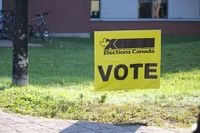As Canada approaches its 45th federal election on April 28, 2025, the political landscape is teetering on a narrow edge, with the Liberal Party led by Mark Carney holding a slight lead over the Conservative Party under Pierre Poilievre. According to the Angus Reid Institute's final data set released on April 26, the Liberals are favored by 44% of voters, compared to 40% for the Conservatives. This four-point margin underscores a competitive race, with the Bloc Québécois and the New Democratic Party (NDP) garnering 7% and 6% support, respectively.
The dynamics of voter turnout are crucial. Early indications show that advance voters leaned heavily towards the Liberals, with 46% casting their ballots for Carney's party compared to just 34% for the Conservatives. However, as Election Day approaches, undecided voters are showing a more even split, with both major parties at 38% among those yet to vote. This suggests that the final outcome may hinge on who can mobilize their supporters most effectively on election day.
Interestingly, the campaign has been marked by a significant focus on leadership rather than party affiliation. When asked to consider their vote based solely on party, without the influence of the leaders, the Conservatives would maintain their 40% support, while the Liberals would plummet to just 28%. This shift highlights how critical personal favorability is in this election cycle.
As the campaign winds down, all three major leaders—Carney, Poilievre, and NDP leader Jagmeet Singh—have experienced a decline in momentum. While Carney enjoys a majority favorability rating, his negatives have risen, reflecting a complex landscape where leaders struggle to maintain positive perceptions. The Conservatives, in particular, have faced criticism for their late platform release, which may have hindered their ability to sway advance voters.
In the lead-up to the election, over 7.3 million Canadians participated in the advance voting period from April 18 to 21, marking a 25% increase from the previous federal election. This surge in participation suggests heightened interest, but also raises questions about how effectively each party can convert this enthusiasm into final votes.
Regional dynamics play a significant role in the election's outcome. The Liberals appear to be regaining ground in key metropolitan areas, particularly in Ontario and Quebec, where they hold significant leads. In contrast, the Conservatives are expected to perform well in western provinces, but their overall national strategy seems to be faltering.
Gender dynamics also factor into the voting patterns, with a clear divide emerging: a plurality of men support the Conservatives, while a majority of women back the Liberals. This gender chasm could be pivotal, particularly as women represent a substantial voting bloc.
Moreover, the political climate has been influenced by external factors, notably the unpopularity of former U.S. President Donald Trump among Canadians. A recent POLITICO/Focaldata poll revealed that three-quarters of Canadians view Trump unfavorably, and his presence looms large over the election. About 39% of voters indicated that Trump's influence is a significant concern in their voting decisions, second only to the cost of living, which is the primary issue for 60% of respondents.
Mark Carney has positioned himself as the candidate best equipped to manage Canada’s relationship with the United States, leveraging his past experience with Trump during his tenure at the G20 and G7. Voters seem to resonate with this narrative, as Carney enjoys a net positive favorability rating, while Poilievre's standing has dipped into negative territory.
In the final stretch, the polls indicate a tight race, with Focaldata reporting that the Liberals lead at 40.5% against the Conservatives at 37.5%. The Liberals are particularly strong in Ontario, where they command a 9-point lead, while the Conservatives maintain a solid footing in western provinces.
Despite the apparent advantages for the Liberals, there remains a notable uncertainty among voters. Approximately one-third of respondents expressed that they might change their minds before casting their final votes. This unpredictability could play a crucial role in determining the election's outcome.
As the election date draws closer, both parties are ramping up their efforts to secure votes. The Conservatives, despite facing criticism over their leadership and platform timing, are attempting to rally support by emphasizing issues like the cost of living and housing. In contrast, the Liberals are banking on Carney's favorable image and urban support to drive turnout.
Ultimately, the election results will reflect not just party loyalty, but also the complex interplay of leadership perceptions, regional dynamics, and external influences. With a tight race and significant voter engagement, April 28 promises to be a pivotal day in Canadian politics.





